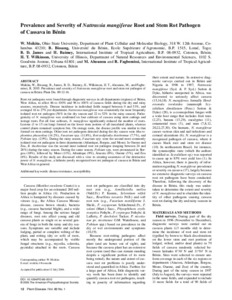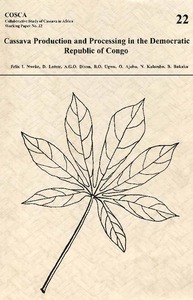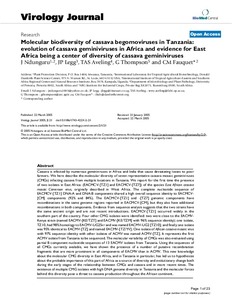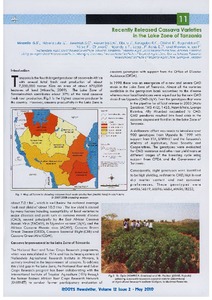| dc.contributor.author | Msikita, W. |
| dc.contributor.author | Bissang, B. |
| dc.contributor.author | James, B. |
| dc.contributor.author | Baimey, H. |
| dc.contributor.author | Wilkinson, H. |
| dc.contributor.author | Ahounou, M. |
| dc.contributor.author | Fagbemissi, R. |
| dc.date.accessioned | 2019-12-04T11:19:02Z |
| dc.date.available | 2019-12-04T11:19:02Z |
| dc.date.issued | 2005 |
| dc.identifier.citation | Msikita, W., Bissang, B., James, B., Baimey, H., Wilkinson, H., Ahounou, M. & Fagbemissi, R. (2005). Prevalence and severity of Nattrassia mangiferae root and stem rot pathogen of cassava in Benin. Plant Disease, 89(1), 12-16. |
| dc.identifier.issn | 0191-2917 |
| dc.identifier.uri | https://hdl.handle.net/20.500.12478/3382 |
| dc.description.abstract | Root rot pathogens were found through diagnostic surveys in all departments (regions) of Bénin, West Africa, to affect 86 to 100% and 96 to 100% of cassava fields during the dry and rainy seasons, respectively. Disease incidence in individual fields ranged between 0 and 53%, and averaged 16 to 27% per department. Nattrassia mangiferae was consistently the most frequently isolated root rot pathogen (56% in the dry season and 22 to 52% in the rainy season). Pathogenicity of N. mangiferae was confirmed on four cultivars of cassava using stem cuttings and storage roots. For all four cultivars, N. mangiferae significantly reduced the number of roots. Lesions (3 to 15 cm long) formed on the lower stem portion of all inoculated plants, whereas control plants remained symptom free. On storage roots, the disease profile was similar to that formed on stem cuttings. Other root rot pathogens detected during the dry season were Macrophomina phaseolina (14.2%), Fusarium spp. (11.8%), Botryodiplodia theobromae (7.7%), and Pythium spp. (2.9%). During the rainy season, Fusarium spp. were the second most commonly isolated root rot pathogens in three departments (Atlantique, Borgou, and Mono). In Oueme and Zou, B. theobromae was the second most isolated root rot pathogen (ranging between 24 and 28%) during the rainy season. During the same season, Pythium spp. were pronounced in Borgou (18%), followed by Mono (11%), Atlantique (9%), Atacora (8%), Oueme (5%), and Zou (6%). Results of the study are discussed with a view to creating awareness of the destructive power of N. mangiferae, a hitherto poorly recognized root rot pathogen of cassava in Bénin and West Africa in general. |
| dc.language.iso | en |
| dc.subject | Disease Resistance |
| dc.subject | Susceptibility |
| dc.subject | Fusarium Species |
| dc.subject | Cassava Root Rot Pathogens |
| dc.subject | Nattrassia Mangiferae |
| dc.subject | Cassava |
| dc.subject | Africa Cassava Mosaic Disease |
| dc.subject | Cassava Brown Streak |
| dc.title | Prevalence and severity of Nattrassia mangiferae root and stem pathogen of cassava in Benin |
| dc.type | Journal Article |
| dc.description.version | Peer Review |
| cg.contributor.affiliation | Ohio State University |
| cg.contributor.affiliation | Université du Bénin |
| cg.contributor.affiliation | International Institute of Tropical Agriculture |
| cg.contributor.affiliation | University of Illinois |
| cg.coverage.region | Acp |
| cg.coverage.region | Africa |
| cg.coverage.region | North America |
| cg.coverage.region | West Africa |
| cg.coverage.country | United States |
| cg.coverage.country | Benin |
| cg.isijournal | ISI Journal |
| cg.authorship.types | CGIAR and developing country institute |
| cg.iitasubject | Plant Diseases |
| cg.iitasubject | Plant Genetic Resources |
| cg.iitasubject | Plant Production |
| cg.iitasubject | Disease Control |
| cg.iitasubject | Cassava |
| cg.iitasubject | Farm Management |
| cg.iitasubject | Genetic Improvement |
| cg.iitasubject | Handling, Transport, Storage And Protection Of Agricultural Products |
| cg.iitasubject | Livelihoods |
| cg.iitasubject | Plant Breeding |
| cg.iitasubject | Pests Of Plants |
| cg.accessibilitystatus | Open Access |
| local.dspaceid | 95056 |
| cg.identifier.doi | https://dx.doi.org/10.1094/PD-89-0012 |




